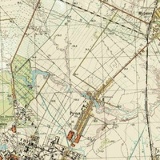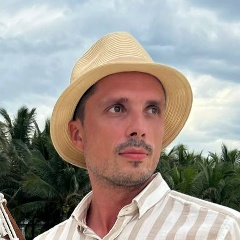Потрясающие вещи иногда происходят на периферии культурных течений: то, что невозможно представить в мэйнстриме, будет скромно красоваться где-то сбоку до той поры, пока случайный прохожий не обнаружит его на своем пути и не поразится фантазии его создателей.
Есть ли в этом мире что-то менее совместимое, чем православие и авангард? Православие цепляется за свои традиции, дышать без них не может, а авангард — плюнул на все (особенно на православие), разворотил и строит новое на обломках никому не нужного старья. Попытайтесь, например, представить Храм Христа Спасителя, который спроектировал бы Казимир Малевич, а еще лучше — Эль Лисицкий. (Ой, а прикольно было бы!)
Кстати, речь идет именно о православии, оно почему-то отличается особой ригидностью и претензиями к формальной стороне вопроса. Соседи-протестанты вот уже давно вовсю развлекаются с храмовой архитектурой, порой, возможно, и ей в ущерб. Приезжаешь в Финляндию, гуляешь по городам и вечно путаешь религиозные сооружения с электроподстанциями и пожарными частями. А родное православие доверяет только тому, что проверено даже не веками — тысячелетиями, поэтому и новые строящиеся храмы — можно не сомневаться — будут предсказуемо стройными, светлыми и... простите, скучными.
А я вот тут узнала, что во Франции в местечке Муазене стоит православный храм, выполненный по откровенно авангардисткому проекту. Бетонная конструкция (как это было модно в 1920-30-е годы), сплошные изломы и наклоны, ни одного прямого угла, камень в торцовой части (привет, финно-угорский модерн). Но при этом алтарь, иконостас и маковка с крестом. Строил, как нетрудно догадаться, некий эмигрант из России. О. Евфимий, в миру Григорий Вендт, по образованию инженер-механик, после революции 1918 года советскую власть не поддержал и эмигрировал в Париж. Позднее принял монашеский сан и вот практически самостоятельно построил этот храм. Про него неизвестно почти ничего, но, например, есть факт, что его авангардисткие взгляды были сформированы под влиянием творчества Велимира Хлебникова. Философия футуризма каким-то хитрым образом переплелась у него в голове с религиозным опытом, а в итоге получился вот такой архитектурный курьез. Казанский скит в Муазене. По-французски, кстати, Skite Notre-Dame-de-Kazan.
Жалко, что этот случай уникален. Религия бы много выиграла, если бы шла в ногу со временем.
Подробнее про храм по ссылке. Там комментарий искусствоведа, интересно.
http://4.bp.blogspot.com/-69hCiHEBI0M/T0wCBg38n2I/AAAAAAAAAFc/mVMN3zojnHA/s1600/P1040895-1.JPG
http://ruskite-notredame-de-kazan.blogspot.ru/2012/02/blog-post_28.html?spref=fb
Есть ли в этом мире что-то менее совместимое, чем православие и авангард? Православие цепляется за свои традиции, дышать без них не может, а авангард — плюнул на все (особенно на православие), разворотил и строит новое на обломках никому не нужного старья. Попытайтесь, например, представить Храм Христа Спасителя, который спроектировал бы Казимир Малевич, а еще лучше — Эль Лисицкий. (Ой, а прикольно было бы!)
Кстати, речь идет именно о православии, оно почему-то отличается особой ригидностью и претензиями к формальной стороне вопроса. Соседи-протестанты вот уже давно вовсю развлекаются с храмовой архитектурой, порой, возможно, и ей в ущерб. Приезжаешь в Финляндию, гуляешь по городам и вечно путаешь религиозные сооружения с электроподстанциями и пожарными частями. А родное православие доверяет только тому, что проверено даже не веками — тысячелетиями, поэтому и новые строящиеся храмы — можно не сомневаться — будут предсказуемо стройными, светлыми и... простите, скучными.
А я вот тут узнала, что во Франции в местечке Муазене стоит православный храм, выполненный по откровенно авангардисткому проекту. Бетонная конструкция (как это было модно в 1920-30-е годы), сплошные изломы и наклоны, ни одного прямого угла, камень в торцовой части (привет, финно-угорский модерн). Но при этом алтарь, иконостас и маковка с крестом. Строил, как нетрудно догадаться, некий эмигрант из России. О. Евфимий, в миру Григорий Вендт, по образованию инженер-механик, после революции 1918 года советскую власть не поддержал и эмигрировал в Париж. Позднее принял монашеский сан и вот практически самостоятельно построил этот храм. Про него неизвестно почти ничего, но, например, есть факт, что его авангардисткие взгляды были сформированы под влиянием творчества Велимира Хлебникова. Философия футуризма каким-то хитрым образом переплелась у него в голове с религиозным опытом, а в итоге получился вот такой архитектурный курьез. Казанский скит в Муазене. По-французски, кстати, Skite Notre-Dame-de-Kazan.
Жалко, что этот случай уникален. Религия бы много выиграла, если бы шла в ногу со временем.
Подробнее про храм по ссылке. Там комментарий искусствоведа, интересно.
http://4.bp.blogspot.com/-69hCiHEBI0M/T0wCBg38n2I/AAAAAAAAAFc/mVMN3zojnHA/s1600/P1040895-1.JPG
http://ruskite-notredame-de-kazan.blogspot.ru/2012/02/blog-post_28.html?spref=fb
Stunning things sometimes happen on the periphery of cultural currents: what is impossible to imagine in the mainstream, will modestly flaunt somewhere on the side until the occasional passer-by finds him in his path and marvels at the imaginations of its creators.
Is there anything less compatible in this world than Orthodoxy and avant-garde? Orthodoxy clings to its traditions, cannot breathe without them, and the vanguard spat on everything (especially on Orthodoxy), spoiled and builds new on the rubble of no-use junk. Try, for example, to present the Cathedral of Christ the Savior, who would have been designed by Kazimir Malevich, and even better - by El Lissitzky. (Oh, and it would be cool!)
By the way, we are talking about Orthodoxy, for some reason it is distinguished by a special rigidity and pretensions to the formal side of the issue. Neighboring Protestants have long been having fun with temple architecture, sometimes, perhaps, to her detriment. You come to Finland, walk around the cities and always confuse religious buildings with electrical substations and fire stations. And native Orthodoxy trusts only what has been tested, not even for centuries - for millennia, therefore new temples being built - no doubt - will be predictably slender, light and ... sorry, boring.
And here I learned that in France in the town of Muazen there is an Orthodox church, made by a frankly avant-garde project. Concrete construction (as it was fashionable in the 1920s – 30s), continuous fractures and inclinations, not a single right angle, a stone in the end part (hello, Finno-Ugric modernist style). But at the same time, the altar, iconostasis and poppy with a cross. It was built, as it is not difficult to guess, a certain emigrant from Russia. O. Evfimy, in the world of Gregory Wendt, a mechanical engineer by training, did not support the Soviet government after the revolution of 1918 and emigrated to Paris. Later he took the monastic rank and now almost independently built this temple. About him, almost nothing is known, but, for example, there is a fact that his avant-garde views were shaped under the influence of Velimir Khlebnikov's works. The philosophy of futurism in some tricky way intertwined in his head with religious experience, but in the end it turned out such an architectural curiosity. Kazan monastery in Moisen. In French, by the way, Skite Notre-Dame-de-Kazan.
It is a pity that this case is unique. Religion would have won a lot if it kept pace with the times.
More about the temple on the link. There's an art critic's comment, interesting.
http://4.bp.blogspot.com/-69hCiHEBI0M/T0wCBg38n2I/AAAAAAAAAFc/mVMN3zojnHA/s1600/P1040895-1.JPG
http://ruskite-notredame-de-kazan.blogspot.ru/2012/02/blog-post_28.html?spref=fb
Is there anything less compatible in this world than Orthodoxy and avant-garde? Orthodoxy clings to its traditions, cannot breathe without them, and the vanguard spat on everything (especially on Orthodoxy), spoiled and builds new on the rubble of no-use junk. Try, for example, to present the Cathedral of Christ the Savior, who would have been designed by Kazimir Malevich, and even better - by El Lissitzky. (Oh, and it would be cool!)
By the way, we are talking about Orthodoxy, for some reason it is distinguished by a special rigidity and pretensions to the formal side of the issue. Neighboring Protestants have long been having fun with temple architecture, sometimes, perhaps, to her detriment. You come to Finland, walk around the cities and always confuse religious buildings with electrical substations and fire stations. And native Orthodoxy trusts only what has been tested, not even for centuries - for millennia, therefore new temples being built - no doubt - will be predictably slender, light and ... sorry, boring.
And here I learned that in France in the town of Muazen there is an Orthodox church, made by a frankly avant-garde project. Concrete construction (as it was fashionable in the 1920s – 30s), continuous fractures and inclinations, not a single right angle, a stone in the end part (hello, Finno-Ugric modernist style). But at the same time, the altar, iconostasis and poppy with a cross. It was built, as it is not difficult to guess, a certain emigrant from Russia. O. Evfimy, in the world of Gregory Wendt, a mechanical engineer by training, did not support the Soviet government after the revolution of 1918 and emigrated to Paris. Later he took the monastic rank and now almost independently built this temple. About him, almost nothing is known, but, for example, there is a fact that his avant-garde views were shaped under the influence of Velimir Khlebnikov's works. The philosophy of futurism in some tricky way intertwined in his head with religious experience, but in the end it turned out such an architectural curiosity. Kazan monastery in Moisen. In French, by the way, Skite Notre-Dame-de-Kazan.
It is a pity that this case is unique. Religion would have won a lot if it kept pace with the times.
More about the temple on the link. There's an art critic's comment, interesting.
http://4.bp.blogspot.com/-69hCiHEBI0M/T0wCBg38n2I/AAAAAAAAAFc/mVMN3zojnHA/s1600/P1040895-1.JPG
http://ruskite-notredame-de-kazan.blogspot.ru/2012/02/blog-post_28.html?spref=fb

У записи 10 лайков,
0 репостов.
0 репостов.
Эту запись оставил(а) на своей стене Полина Оскольская































